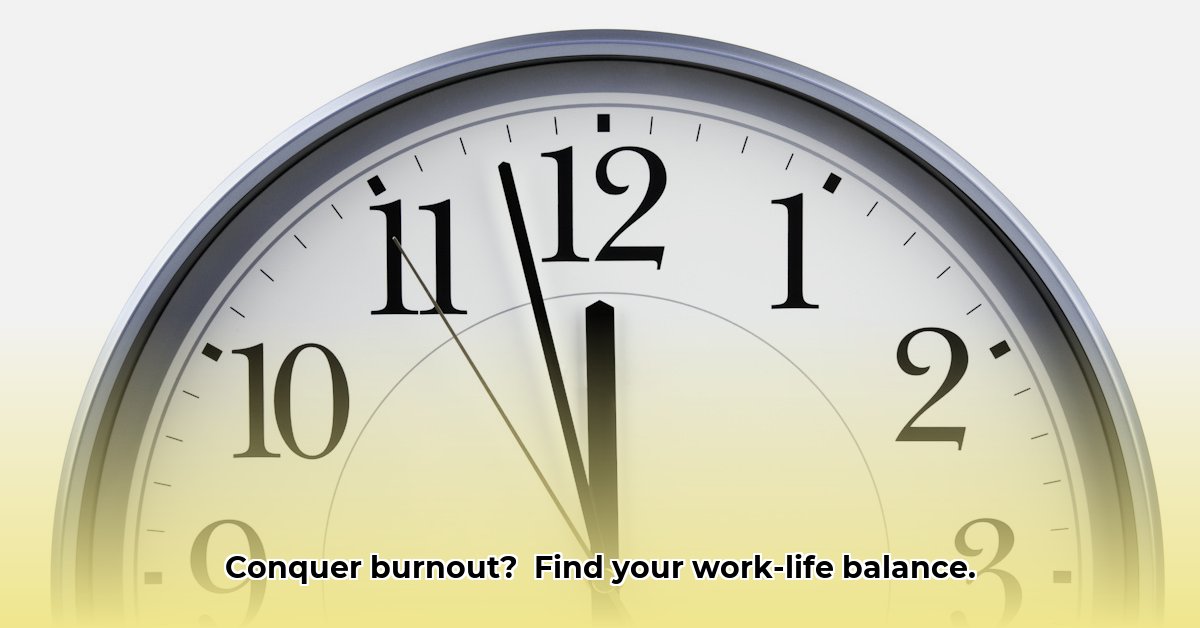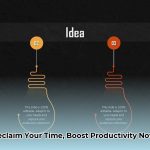Feeling buried under a mountain of responsibilities, struggling to juggle work and personal life? You’re not alone. Many people grapple with the constant pressure to excel in their careers while maintaining a healthy, happy personal life. This comprehensive guide offers practical, actionable strategies to reclaim control of your time and create a more balanced, fulfilling existence. You’ll discover simple yet effective techniques, relatable examples, and practical tools to facilitate lasting change. For even more in-depth strategies, check out this great resource. Whether you’re seeking immediate relief or a long-term plan, these strategies will empower you to feel more in control, reduce stress, and ultimately conquer overwhelm.
The Ultimate Guide to Time Management and Work-Life Harmony
The relentless pursuit of career success often comes at the expense of a fulfilling personal life. Millions struggle to find a harmonious balance, leading to burnout, stress, and a diminished sense of well-being. But what if the key wasn’t working harder, but smarter? This definitive guide reveals how to master time management, cultivate a fulfilling life, and achieve true work-life harmony. By identifying and eliminating time-wasting activities and implementing proven strategies, you’ll conquer overwhelm and create a life you truly love.
Identifying Your Personal Time Thieves
Before you can solve the problem, you need to understand it. What activities are draining your time and energy each day? Where does your time actually go? Do endless emails and unproductive meetings consume your workday? Do you find yourself mindlessly scrolling through social media, unaware of the hours slipping away? Identifying these common time-wasters is the crucial first step toward reclaiming control.
Consider the Pareto Principle (the 80/20 rule): 80% of our results often come from 20% of our efforts. Are you focusing on the right 20%? Which activities generate the most significant impact in your work and personal life? Identifying that crucial 20% is key to maximizing your time and energy.
Your Comprehensive Action Plan: Proven Steps to Achieve Balance
Now that we’ve pinpointed the problem, let’s explore the solutions. This action plan provides a proven framework for achieving lasting success:
Step 1: Conduct a Detailed Time Audit – Become a Time Detective!
- Meticulously Track Your Time: For one week, diligently record everything you do, noting the precise time spent on each task. Be brutally honest; even those short distractions add up! Use a time tracking app or spreadsheet for accuracy.
- Categorize Your Activities: Group your tasks into meaningful categories: work, family, commuting, personal time, sleep, chores, etc. This provides a clear overview of how you spend your time.
- Unmask the Time Sinks: Analyze your time log to identify the activities that consistently consume more time than they should. These are your prime targets for improvement.
Step 2: Prioritize Like a Pro – Master the Art of Saying No!
- The Eisenhower Matrix (Urgent/Important): This powerful tool helps you prioritize tasks based on their urgency and importance.
- Urgent and Important: Do these tasks immediately.
- Important but Not Urgent: Schedule these tasks for later.
- Urgent but Unimportant: Delegate these tasks if possible.
- Not Urgent and Not Important: Eliminate these tasks entirely.
- Master the Art of Saying “No”: Protect your time by saying “no” to additional tasks or commitments that don’t align with your priorities or goals. Remember, every “yes” to a low-value activity is a “no” to something more important.
Step 3: Choose Your Time Management Arsenal – Experiment and Find Your Perfect Fit!
Numerous effective time management methods exist. Experiment with different approaches to discover what aligns best with your personality, work style, and individual needs.
- The Pomodoro Technique: Work in focused bursts (e.g., 25 minutes) followed by short breaks (e.g., 5 minutes). This technique enhances concentration and prevents burnout.
- Time Blocking: Schedule specific blocks of time for particular tasks or activities. Treat these blocks as non-negotiable appointments with yourself.
- Eat the Frog (Tackle the Toughest Task First): Begin your day by tackling your most challenging or unpleasant task. Completing this task first boosts your confidence and sets a positive tone for the rest of the day.
- Getting Things Done (GTD): Capture all your tasks and ideas in a trusted system, organize them into actionable steps, and schedule them strategically.
Step 4: Set SMART Goals – Achieve Meaningful Progress!
- Break Down Big Projects: Divide large, complex projects into smaller, more manageable steps. This makes the overall goal feel less daunting and more achievable.
- Set SMART Goals: Ensure your goals are Specific, Measurable, Achievable, Relevant, and Time-bound. This provides clarity and focus.
- Reward Yourself: Celebrate your accomplishments, no matter how small. Acknowledge your progress and reward yourself for achieving milestones.
Step 5: Establish Clear Boundaries – Protect Your Personal Time!
- Dedicated Work Hours: Define specific work hours and adhere to them as consistently as possible. This helps create a clear separation between work and personal life.
- Designated Workspace: Create a dedicated workspace, separate from your relaxation areas. This helps you mentally transition between work and leisure.
- Email Boundaries: Avoid checking work emails outside of work hours, unless absolutely necessary. Disconnect from work-related communication during personal time.
Tools and Technology: Maximize Your Efficiency
Leverage technology to enhance your time management efforts. A wide range of apps and software can assist you in organizing tasks, managing your schedule, and promoting mental well-being.
- Calendar Apps: Google Calendar, Outlook Calendar, Apple Calendar
- Task Managers: Todoist, Trello, Asana, Microsoft To Do
- Note-Taking Apps: Evernote, OneNote, Google Keep
- Focus Apps: Freedom, Forest, Cold Turkey
- Meditation Apps: Headspace, Calm
The Employer’s Pivotal Role in Fostering Work-Life Harmony
Employers play a vital role in creating a supportive work environment that promotes work-life balance. Supporting employee well-being is not only ethical but also a smart business strategy.
- Flexible Work Arrangements: Offer flexible work hours, remote work options, and compressed workweeks.
- Time Management Training: Provide training on effective time management techniques and stress management strategies.
- Promote Open Communication: Encourage open communication between employees and managers regarding workload, stress levels, and work-life balance concerns.
- Wellness Programs: Implement wellness programs that promote physical and mental health.
Long-Term Strategies: Building a Balanced and Sustainable Life
Achieving a balanced life is an ongoing journey of continuous refinement and adaptation.
- Regularly Refine Your Approach: Continuously evaluate your time management techniques and adapt them to your evolving needs and priorities.
- Practice Mindfulness: Incorporate mindfulness and stress-reduction techniques (meditation, yoga, deep breathing exercises) into your daily routine.
- Prioritize Self-Care: Schedule dedicated time for activities that nurture your mind, body, and spirit. This might include exercise, spending time in nature, pursuing hobbies, or simply relaxing with a good book.
- Seek Support: Don’t hesitate to seek support from friends, family, or a professional therapist or counselor if you’re struggling to manage stress or achieve work-life balance.
By consistently implementing these strategies, you’ll not only boost your productivity but also dramatically improve your overall well-being. Embrace the journey, knowing that a fulfilled, balanced life is within your reach.
Tailoring Time Management to Your Unique Personality
Feeling overwhelmed and struggling to manage your time effectively? It’s time to rethink your approach. The key isn’t just managing time, but personalizing your time management techniques to align with your unique personality, strengths, and preferences.
Understanding Your Personality Type
Before diving into specific strategies, take some time to understand your personality type.
- Myers-Briggs Type Indicator (MBTI): A widely used personality assessment that identifies preferences based on four dichotomies: Extraversion (E) or Introversion (I), Sensing (S) or Intuition (N), Thinking (T) or Feeling (F), and Judging (J) or Perceiving (P).
- Enneagram: A system that identifies nine interconnected personality types, each with its own core beliefs, motivations, and fears.
- DISC Assessment: A behavioral assessment that identifies four main personality traits: Dominance (D), Influence (I), Steadiness (S), and Conscientiousness (C).
Tailoring Time Management Based on Personality
Once you’ve identified your personality type, consider these adaptations to optimize your time management strategies:
- Extroverts: Schedule regular social interaction and collaborative time. Break down large tasks into smaller, collaborative chunks.
- Introverts: Allocate ample solo time for focused work. Minimize interruptions and prioritize deep work sessions.
- Judging (J) Types: Embrace detailed planning and structured schedules. Utilize checklists and deadlines.
- Perceiving (P) Types: Allow for flexibility in your schedule. Focus on prioritizing based on urgency and interest.
- Thinking (T) Types: Focus on logical analysis and objective decision-making. Utilize data and metrics to track progress.
- Feeling (F) Types: Consider the impact of your decisions on others. Prioritize tasks that align with your values and contribute to harmony.
Practical Strategies for Every Personality
Regardless of your personality type, these core techniques can optimize your time management:
- Prioritize Ruthlessly: Utilize the Eisenhower Matrix (urgent/important) to focus on the most crucial tasks first.
- Batch Similar Tasks: Group related activities (e.g., responding to emails, making phone calls) to improve efficiency.
- Time Blocking: Allocate specific time slots for different activities. Treat these blocks as non-negotiable appointments.
- Utilize Technology Wisely: Leverage productivity apps and tools to support your workflow.
Overcoming Common Time Management Challenges
Many individuals, regardless of personality type, face common time management challenges:
- Procrastination: Break down overwhelming tasks into smaller, manageable steps.
- Perfectionism: Strive for excellence, but accept that “good enough” is often sufficient.
- Distractions: Minimize interruptions and identify your biggest distractors.
Actionable Steps for Lasting Change
- Identify Your Peak Productivity Times: Schedule your most demanding tasks during your most energetic periods.
- Learn to Delegate: Don’t try to do everything yourself. Delegate tasks where possible.
- Practice Self-Compassion: Time management is a journey, not a destination.
Effective Time Management Strategies for Remote Workers
Designing Your Ideal Remote Workspace
Think of your workspace as your personal command center. It should be both functional and inspiring, optimizing your focus and energy.
- Optimize for Focus: Minimize distractions by choosing a quiet location. If that’s unattainable, consider noise-canceling headphones.
- Ergonomics Matter: Invest in a comfortable chair, monitor stand, and keyboard to prevent physical strain.
- Personalize Your Space: Add elements that inspire you, like plants, artwork, or motivational quotes. Natural light is a plus!
Mastering Task Prioritization: Techniques and Tools
Effective task prioritization is essential for remote workers seeking optimal productivity.
- The Eisenhower Matrix (Urgent/Important): Categorize tasks based on their urgency and importance.
- Time Blocking: Schedule specific blocks of time for dedicated tasks, creating structure and focus.
- Pomodoro Technique: Work in focused bursts (e.g., 25 minutes) followed by short breaks (e.g., 5 minutes).
The Importance of Scheduled Breaks and Self-Care
Remote work can blur the lines between work and personal life, making scheduled breaks and self-care even more crucial for preventing burnout.
- Step Away From Your Screen: Take short breaks every hour to stretch, walk around, or simply rest your eyes.
- Integrate Mindfulness: Practice mindfulness techniques such as meditation or deep breathing exercises to reduce stress and enhance focus.
- Make Self-Care a Priority: Schedule dedicated time for activities you enjoy, such as exercising, reading, or spending time with loved ones.
Communication is Key: Setting Boundaries and Expectations
Effective communication is paramount for remote teams to ensure clarity, alignment, and productivity.
- Over-Communicate: Schedule regular check-ins with your team and manager to ensure everyone is on the same page.
- Use Project Management Tools: Utilize project management tools like Asana, Trello, or Jira to organize tasks, track progress, and manage deadlines.
- Define Work Hours: Clearly communicate your work hours to colleagues and clients to set expectations and prevent interruptions during personal time.
Adapting Strategies to Your Unique Needs
There’s no one-size-fits-all approach to time management for remote workers. Experiment with different techniques and tools to discover what works best for your individual needs and preferences.
Long-Term Strategies: Continuous Improvement and Support
Cultivate a growth mindset , viewing challenges as opportunities for learning and development. Seek feedback from colleagues and mentors, and continuously refine your time management strategies.
Effective Time Management Techniques for High-Stress Professions
Understanding Your Time
Before implementing any time management techniques, it’s essential to understand how you currently spend your time. Conducting a time audit provides valuable insights into your daily activities, revealing patterns and identifying time-wasting activities.
- Track Your Activities: Use a time tracking app or spreadsheet to meticulously record your activities for one week.
- Categorize Your Activities: Group your tasks into categories such as meetings, emails, projects, and administrative tasks.
- Identify Time Vampires: Analyze your time log to identify the activities that consume the most time and energy.
Prioritization: The Art of Saying “No”
Effective prioritization is crucial for managing your workload and reducing stress in high-stress professions.
- The Eisenhower Matrix (Urgent/Important): Prioritize tasks based on their urgency and importance.
- Focus on High-Impact Tasks: Identify the tasks that will have the greatest impact on your goals and focus your energy on those activities.
- Learn to Say No: Protect your time by declining low-priority requests and delegating tasks when possible.
Time Blocking: Structuring Your Day
Time blocking involves scheduling specific time slots for dedicated tasks, creating structure and focus in your day.
- Create a Daily Schedule: Plan your day in advance, allocating specific time blocks for different activities.
- Treat Time Blocks as Appointments: Treat your scheduled time blocks as non-negotiable appointments, minimizing distractions and interruptions.
- Be Realistic: Avoid over-scheduling your day. Build in buffer time for unexpected tasks and urgent requests.
Minimize Distractions: Reclaim Your Focus
Distractions are productivity killers, especially in high-stress environments.
- Turn Off Notifications: Disable notifications on your phone, computer, and email to minimize interruptions.
- Close Unnecessary Tabs: Close unnecessary browser tabs and applications to reduce visual clutter.
- Communicate Your Needs: Let your colleagues know when you need uninterrupted time for focused work.
Embrace the Power of Breaks
Regular breaks are essential for maintaining focus, reducing stress, and preventing burnout.
- Take Short Breaks Every Hour: Step away from your desk for a few minutes each hour to stretch, walk around, or simply rest your eyes.
- Schedule Longer Breaks for Lunch and Exercise: Take longer breaks for lunch and exercise to recharge your mind and body.
- Disconnect From Work During Breaks: Avoid checking emails or working on projects during your breaks.
Integrating Technology Wisely
Technology can be a powerful tool for enhancing time management, but it’s important to use it wisely.
- Explore Productivity Apps: Experiment with productivity apps such as task managers, calendar apps, and note-taking apps.
- Automate Repetitive Tasks: Use technology to automate repetitive tasks such as email filtering, scheduling, and data entry.
- Avoid Technology Overload: Don’t fall into the trap of using too many tools or spending too much time managing your technology.
Sustained Success Requires Long-Term Strategies
Remember: a well-rested, centered you is a highly productive you.
- Doctor Work Life Balance: Proven Strategies for Physician Well-being - November 20, 2025
- Find Your Work-Life Harmony: Quotes for a Fulfilling Life - November 18, 2025
- CRNA Work-Life Balance: Strategies for a Healthier Lifestyle - November 16, 2025
















